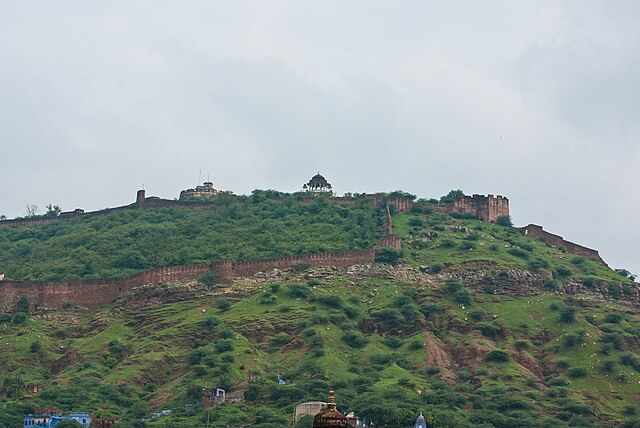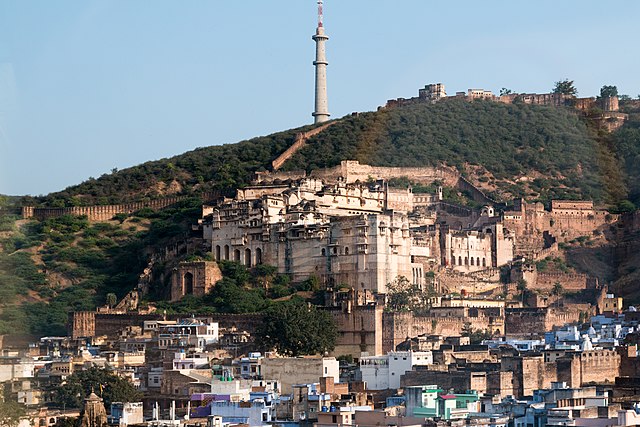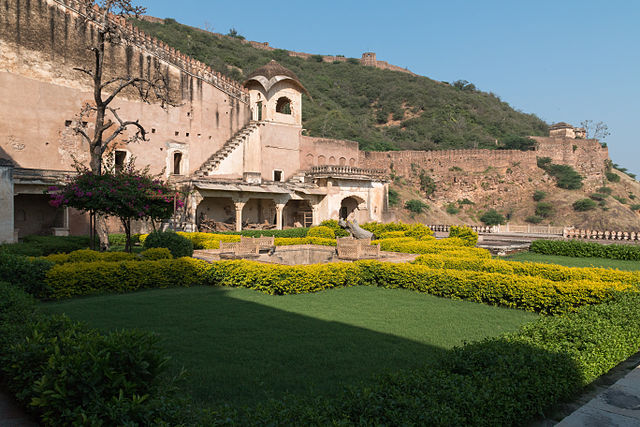Have you ever wondered what it feels like to step back in time and walk through the corridors of medieval India? Taragarh Fort in Bundi, Rajasthan, offers exactly that experience. This magnificent hilltop fortress, often called the “Star Fort,” stands as a testament to Rajput valor and architectural brilliance.
Perched majestically on a steep hillside overlooking the blue city of Bundi, Taragarh Fort isn’t just another tourist destination—it’s a journey through centuries of Indian history. Whether you’re a history buff, architecture enthusiast, or simply someone seeking an offbeat travel experience, this fort promises to captivate your imagination.
What Makes Taragarh Fort Special?
Historical Significance
Taragarh Fort holds the distinction of being one of the most impressive hill forts in Rajasthan. Built in 1354 AD, it served as the seat of power for the Chauhan rulers of Bundi. The fort’s strategic location made it virtually impregnable, earning it the nickname “Star Fort” due to its stellar defensive capabilities.
What sets this fort apart from others in Rajasthan? Unlike the more commercialized forts of Jaipur or Jodhpur, Taragarh maintains its raw, authentic character. You won’t find crowds of tourists here, which means you can explore its ancient passages and chambers at your own pace, almost like a private archaeological adventure.
Architectural Marvel
The fort’s architecture is a fascinating blend of Rajput and Mughal styles. Its massive walls, some reaching heights of over 200 feet, showcase the engineering prowess of medieval Indian architects. The fort complex spans across the entire hilltop, covering an area that would take hours to explore thoroughly.
The construction demonstrates remarkable foresight in defensive planning. Every entrance, corridor, and chamber was designed with warfare in mind, yet the builders never compromised on aesthetic beauty. The intricate carvings, elegant arches, and spacious courtyards reflect the refined taste of Rajput royalty.
The Rich History of Taragarh Fort
Foundation and Early Years
The story of Taragarh Fort begins in the 14th century when Rao Devda, a Chauhan ruler, decided to establish a stronghold that would protect his kingdom from invaders. The choice of location was strategic—the steep hills provided natural defense, while the elevation offered commanding views of the surrounding countryside.
Construction of the fort took several years, with thousands of workers laboring to carve out this fortress from the rocky hillside. The builders used local stone, which not only provided durability but also helped the structure blend seamlessly with the natural landscape.
Chauhan Dynasty Legacy
Under the Chauhan rulers, Taragarh Fort became the epicenter of political and cultural activities in the region. The fort witnessed numerous battles, political alliances, and royal ceremonies. Each ruler added their own touch to the fort’s architecture, creating the complex layered structure we see today.
The Chauhans were known for their patronage of arts and literature. The fort’s walls once echoed with poetry recitations, musical performances, and scholarly debates. Many of the chambers still bear inscriptions and paintings that reflect this rich cultural heritage.
Mughal Influence Period
During the Mughal era, Taragarh Fort experienced significant changes. While it maintained its independence for a considerable time, eventual Mughal influence brought new architectural elements to the fort. You can see this fusion in the later additions, where Mughal-style arches and decorative elements complement the original Rajput design.
The relationship between the local rulers and the Mughal court was complex, involving both conflict and cooperation. This dynamic is reflected in the fort’s architecture, where defensive structures coexist with more ornate, peacetime additions.
Exploring Taragarh Fort Architecture

The Massive Battlements
The first thing that strikes visitors about Taragarh Fort is the sheer scale of its fortifications. The outer walls stretch for miles, following the natural contours of the hillside. These aren’t just walls—they’re masterpieces of military engineering, designed to withstand prolonged sieges and direct assaults.
Walking along these battlements feels like traversing the spine of some ancient stone giant. The views from here are breathtaking, offering panoramic vistas of Bundi city below and the Aravalli hills stretching to the horizon.
Defense Mechanisms
The fort’s defensive features are ingeniously designed. Multiple gates ensure that even if attackers breach one entrance, they face additional barriers. The passages between gates are narrow and winding, creating chokepoints where defenders could effectively counter much larger attacking forces.
Secret tunnels connect different parts of the fort, allowing defenders to move unseen during battles. Some of these tunnels are still accessible today, though exploring them requires caution and preferably a local guide.
Palace Structures Within
Inside the fort complex, you’ll discover remnants of what were once magnificent palaces. Though time and weather have taken their toll, enough remains to showcase the grandeur of Rajput royal architecture. The main palace complex features multiple courtyards, each serving different ceremonial and residential purposes.
The throne room, though partially ruined, still retains an aura of regal dignity. You can almost imagine the Chauhan rulers holding court here, making decisions that would affect the entire region.
Rani Mahal Features
The Rani Mahal (Queen’s Palace) represents the pinnacle of aesthetic refinement within the fort. Despite centuries of neglect, delicate stone carvings still adorn the walls, depicting floral motifs, geometric patterns, and mythological scenes.
The palace was designed with the comfort and privacy of royal women in mind. Intricate jali work (stone lattice screens) allowed the queens to observe court proceedings while maintaining purdah. The chambers are arranged around a central courtyard, creating a sense of community while ensuring individual privacy.
Best Time to Visit Taragarh Fort
Weather Considerations
Timing your visit to Taragarh Fort can make the difference between a memorable experience and an uncomfortable ordeal. The best time to visit is during the winter months from October to March when temperatures are pleasant and hiking up to the fort becomes enjoyable rather than exhausting.
During winter, daytime temperatures hover around 15-25°C, perfect for exploring the extensive fort complex. The clear skies also provide excellent photography opportunities, with the fort’s sandstone walls glowing golden in the soft winter sunlight.
Summer months (April to June) can be brutal, with temperatures soaring above 40°C. The steep climb to the fort becomes particularly challenging during this period. However, if you must visit during summer, plan your trip for early morning hours before 9 AM or after 5 PM.
Festival Seasons
Visiting during local festivals adds an extra dimension to your Taragarh Fort experience. The Bundi Utsav, usually held in October or November, brings the entire region alive with cultural performances, traditional crafts exhibitions, and local cuisine festivals.
During festival times, you might encounter cultural programs being held within the fort premises. These events offer unique opportunities to experience the fort as it was meant to be—alive with music, dance, and celebration.
How to Reach Taragarh Fort Bundi
By Air
The nearest airport to Bundi is Jaipur International Airport, located approximately 210 kilometers away. From Jaipur, you can hire a taxi or take a bus to reach Bundi. The drive takes about 4-5 hours through scenic Rajasthani countryside.
Another option is flying to Udaipur Airport, which is about 200 kilometers from Bundi. This route offers equally beautiful landscapes and might be more convenient depending on your starting location.
By Train
Bundi doesn’t have its own railway station, but you can reach nearby Kota Junction, which is well-connected to major Indian cities. Kota is just 35 kilometers from Bundi, making it the most convenient rail option.
From Kota, regular buses and taxis are available to Bundi. The journey takes about an hour and passes through typical Rajasthani villages, offering glimpses of rural life.
By Road
Bundi is well-connected by road to major Rajasthani cities. If you’re driving from Jaipur, take National Highway 52, which offers good road conditions and beautiful scenery. From Delhi, the drive takes about 6-7 hours via Jaipur.
Local buses operate regularly between Bundi and nearby cities like Kota, Udaipur, and Jaipur. These buses are economical but can be crowded, especially during peak travel seasons.
Entry Fees and Timings
Taragarh Fort is open to visitors throughout the week from sunrise to sunset. The entry fee is nominal—typically around ₹25 for Indian citizens and ₹100 for foreign tourists. These rates may change, so it’s advisable to check current pricing before your visit.
Unlike some commercialized heritage sites, Taragarh Fort doesn’t have strict time restrictions. You can spend hours exploring without feeling rushed. However, climbing to the fort takes about 30-45 minutes, so plan accordingly, especially if you’re visiting during shorter winter days.
The fort doesn’t have modern amenities like cafeterias or souvenir shops, which actually adds to its authentic charm. Carry water and snacks, especially if you plan to spend several hours exploring.
What to See Inside Taragarh Fort
Key Attractions
The fort complex is vast, and exploring it thoroughly requires at least half a day. The main attractions include the ruined palaces, ancient temples, water storage systems, and the famous cannons that once defended the fort.
Start your exploration from the main entrance gate, which itself is an architectural marvel. The massive wooden doors, reinforced with iron spikes, speak of the fort’s defensive priorities. As you enter, you’ll find yourself in a large courtyard that once served as the assembly area for troops.
Bhim Burj
Bhim Burj is perhaps the most impressive structure within the fort complex. This massive cannon, one of the largest medieval cannons in India, was capable of firing cannonballs weighing over 50 kilograms. The cannon is still in remarkably good condition, testament to the metallurgical skills of ancient Indian craftsmen.
The platform where Bhim Burj is mounted offers spectacular views of Bundi city. From here, you can appreciate the strategic importance of the fort’s location and understand why it was considered impregnable.
Ancient Water Tanks
The fort’s water management system showcases the engineering brilliance of its builders. Several large tanks, carved directly into the rock, collected and stored rainwater. These tanks ensured the fort could withstand long sieges without running out of water.
Some of these tanks are still functional and contain water during the monsoon season. The largest tank, near the palace complex, features steps leading down to the water level, creating an almost temple-like atmosphere.
Photography Tips at Taragarh Fort

Taragarh Fort offers incredible photography opportunities, but capturing its essence requires some planning. The golden hour, just after sunrise and before sunset, provides the most dramatic lighting for the fort’s sandstone architecture.
The contrast between the ancient stone structures and the blue city of Bundi below creates compelling compositional opportunities. Wide-angle lenses work well for capturing the fort’s massive scale, while telephoto lenses can isolate interesting architectural details.
Don’t forget to photograph the intricate carvings and stone work up close. Many visitors focus only on the grand views and miss the delicate artistry in the smaller details. The jali work in the Rani Mahal, in particular, offers beautiful patterns and textures.
Nearby Attractions in Bundi
Bundi Palace
After exploring Taragarh Fort, the Bundi Palace complex below is worth a visit. This palace showcases a different architectural style and houses some of the finest miniature paintings in Rajasthan. The palace’s Chitrashala (art gallery) contains murals depicting mythological scenes and court life.
The palace and fort complement each other perfectly, offering visitors a complete picture of Bundi’s royal heritage. Many visitors find that seeing both structures helps them better understand the relationship between defensive and residential architecture in medieval Rajasthan.
Step Wells (Baoris)
Bundi is famous for its step wells, architectural marvels that served both practical and aesthetic purposes. The Raniji ki Baori and Nagar Sagar Kund are particularly impressive, featuring intricate carvings and multiple levels of galleries.
These step wells demonstrate the same engineering ingenuity found in Taragarh Fort, showing how the builders of Bundi consistently prioritized both functionality and beauty in their constructions.
Where to Stay Near Taragarh Fort
Bundi offers accommodation options ranging from heritage hotels to budget guesthouses. For a truly immersive experience, consider staying in one of the heritage hotels that offer views of Taragarh Fort. Waking up to see the fort silhouetted against the morning sky is an unforgettable experience.
Budget travelers will find several clean, comfortable guesthouses in the main market area. These establishments often provide local insights and can arrange guides for fort exploration.
Local Food and Dining Options
No visit to Taragarh Fort is complete without sampling local Rajasthani cuisine. Bundi’s restaurants serve traditional dishes like dal baati churma, gatte ki sabzi, and ker sangri. The flavors are robust and reflect the region’s arid climate and warrior culture.
Several rooftop restaurants in Bundi offer dining with views of Taragarh Fort. Enjoying a traditional Rajasthani thali while gazing up at the illuminated fort creates a magical dining experience.
Travel Tips for Visiting Taragarh Fort
Wear comfortable walking shoes as the path to the fort involves considerable climbing over uneven terrain. Carry sufficient water, especially during warmer months, as there are no facilities available within the fort complex.
A local guide can enhance your experience significantly, sharing stories and historical details that aren’t available in guidebooks. Many guides are descendants of families who lived in the fort area for generations and possess intimate knowledge of its history.
Plan to spend at least 3-4 hours at the fort to explore it properly. Rushing through diminishes the experience and doesn’t allow time to appreciate the architectural details and historical significance.
Conclusion
Taragarh Fort Bundi stands as one of Rajasthan’s most authentic and impressive medieval fortresses. Unlike more commercialized heritage sites, it retains its raw historical character, offering visitors a genuine glimpse into India’s rich past. The fort’s combination of strategic military architecture, refined royal residences, and stunning natural setting creates an experience that resonates long after your visit.
Whether you’re drawn by history, architecture, photography, or simply the adventure of exploring an ancient fortress, Taragarh Fort delivers on all fronts. It represents not just a tourist destination, but a journey through time that connects you with the courage, creativity, and cultural sophistication of medieval India.
The fort reminds us that history isn’t just about dates and events—it’s about human stories carved in stone, waiting for curious travelers to discover and appreciate them.
Frequently Asked Questions
1. How long does it take to climb to Taragarh Fort from Bundi city?
The climb to Taragarh Fort typically takes 30-45 minutes depending on your fitness level and pace. The path is steep but well-defined, and the effort is rewarded with spectacular views and an amazing historical experience.
2. Is Taragarh Fort suitable for elderly visitors or those with mobility issues?
The fort requires significant climbing and walking over uneven terrain, making it challenging for elderly visitors or those with mobility issues. However, the lower sections can be accessed with moderate effort, and even a partial visit is worthwhile.
3. Are there any restrictions on photography inside Taragarh Fort?
Generally, photography is allowed throughout the fort complex for personal use. However, it’s always best to check with local authorities or your guide about any specific restrictions, especially regarding commercial photography.
4. Can Taragarh Fort be visited during monsoon season?
While the fort can be visited during monsoon (July-September), extra caution is needed as paths can become slippery. The advantage is that the surrounding landscape becomes lush green, offering different but equally beautiful photographic opportunities.
5. What should I carry when visiting Taragarh Fort?
Essential items include comfortable walking shoes, sufficient water (at least 1-2 liters per person), snacks, sun protection (hat, sunscreen), a camera, and possibly a flashlight for exploring darker sections of the fort. Also carry some cash for the entry fee and guide services.

